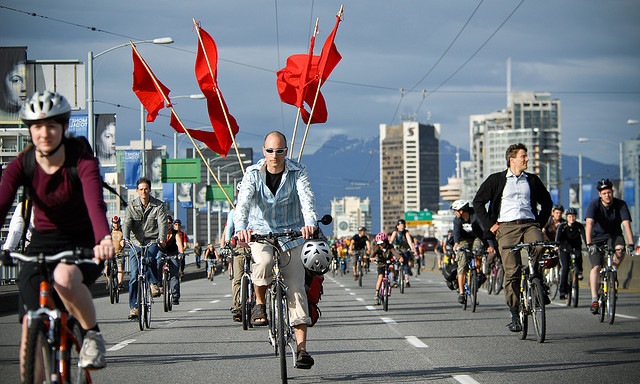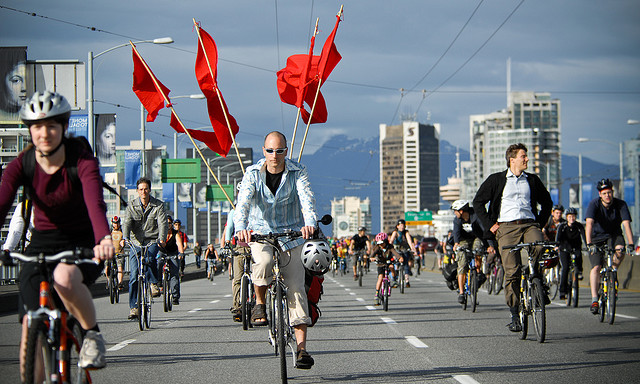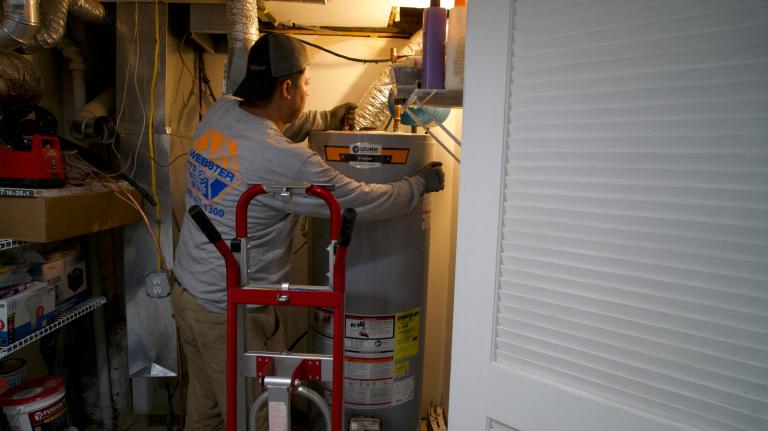 A scene from the June 2007 Critical Mass bike ride in Vancouver.Photo: Tavis FordElly Blue is on a monthlong Dinner & Bikes tour around the western U.S., along with Portland bike filmmaker Joe Biel and traveling vegan chef Joshua Ploeg. This is one of her thrice-weekly dispatches from the road about bicycle culture and economy. Read them all here.
A scene from the June 2007 Critical Mass bike ride in Vancouver.Photo: Tavis FordElly Blue is on a monthlong Dinner & Bikes tour around the western U.S., along with Portland bike filmmaker Joe Biel and traveling vegan chef Joshua Ploeg. This is one of her thrice-weekly dispatches from the road about bicycle culture and economy. Read them all here.
Phoenix, Ariz.: I’m quizzing Nathan Leach, our host tonight on the Dinner & Bikes tour, about local bike culture. Leach is the main force behind the Rusty Spoke bicycle collective. He organizes the local version of Critical Mass, the monthly bike ride designed to claim a piece of the pavement for the human-powered set.
“Are there any other organized rides?” I ask. Not really, he says. There isn’t even a local bicycle advocacy organization, though one guy keeps trying to start one. Critical Mass is it. A few times they’ve had 100 riders, though, which he says is huge for Phoenix. Still, it’s barely a blip on the radar in this city of nearly 1.5 million.
Since its inception in San Francisco in 1992, Critical Mass has been the hardy seed of the bicycle movement. Even in the world’s least bike-friendly places, riders fulfill a vision of streets filled with bicycles. The event serves as an incubator for connections, leadership, and political pressure that have been the motivating force behind much of today’s bicycle movement.
But in many places, the ride has developed a reputation for whipping up hordes of violent and confrontational young men who yell at people and blow through red lights. Earlier this year, a motorist plowed through a crowd of cyclists at a Critical Mass ride in Porto Alegre, Brazil. And some of the most vehement detractors are bicycle advocates, who argue that the event does more harm than good.
In response to this less-than-sparkly reputation, San Diego cyclists started a ride called “Courteous Mass.” At Bike Party, a monthly ride in San Jose, Calif., that draws several thousand riders, participants are asked stop at every stop sign. One of Bike Party’s founders, a young schoolteacher named Jo, told us that organizers began breaking up the event into several smaller rides when the group became so large it was hard to work everyone through traffic lights. She hadn’t been as closely involved recently, but said she has been disappointed by Bike Party’s recent anti-Critical Mass tone. “Why dump on Critical Mass?” she said. “This wouldn’t exist without Critical Mass.”
And in some places, at least, Critical Mass has made a difference. One of the films Joe is showing on our tour is the trailer for a feature documentary on the topic called Aftermass: A Post-Critical Mass Portland. The trailer features a former city commissioner saying that Critical Mass was hugely influential in giving Portland’s bike-friendly leaders the political cover needed to start rolling out that city’s now-famous bike infrastructure.
But riders are still frustrated. Earlier on our tour in San Diego, we met Samantha Ollinger, the blogger behind BikeSD.org. She has written about why she thinks Critical Mass continues despite its increasingly bad reputation in that city:
“San Diego’s Regional Transportation Plan does call for increasing ridership, but without a concentrated effort to give the cyclists what they are demanding — real estate — cycling in San Diego will continue to be the domain of a select few. Thus, it is no wonder that cyclists continue to gather on a monthly basis to assert their right to be on the road demanding space that is repeatedly denied to them.” (Read the full post here.)
Ultimately, Critical Mass’s complete and utter loss of the PR war may be yet another contribution to the bicycle movement: It allows the bicycle advocates who denounce it to appear more sane. Which is great up to a point — until Critical Mass destructs under the weight of its negative public opinion.
In Phoenix, that seems a long way off. Too small to be unpopular, the local Critical Mass ride is slowly and quietly building a movement of excited and empowered grassroots bike leaders. When the angry editorials start to appear, we’ll know that the Phoenix bike movement has arrived.



